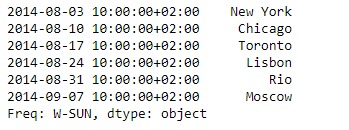Pandas 系列是带有轴标签的一维ndarray。标签不必是唯一的,但必须是可哈希的类型。该对象同时支持基于整数和基于标签的索引,并提供了许多方法来执行涉及索引的操作。
Pandas Series.slice_shift()函数等效于不复制数据的移位。移位的数据将不包括丢失的周期,并且移位的轴将小于原始数据。
用法: Series.slice_shift(periods=1, axis=0)
参数:
periods:移动的周期数,可以是正数或负数
返回:平移:与调用者类型相同
范例1:采用Series.slice_shift()函数将给定Series对象的数据移动2个周期。
# importing pandas as pd
import pandas as pd
# Creating the Series
sr = pd.Series(['New York', 'Chicago', 'Toronto', 'Lisbon', 'Rio', 'Moscow'])
# Create the Datetime Index
didx = pd.DatetimeIndex(start ='2014-08-01 10:00', freq ='W',
periods = 6, tz = 'Europe/Berlin')
# set the index
sr.index = didx
# Print the series
print(sr)输出:

现在我们将使用Series.slice_shift()函数将给定系列对象中的数据移动2个周期。
# shift by 2 periods
sr.slice_shift(periods = 2)输出:

正如我们在输出中看到的,Series.slice_shift()函数已成功将数据移到索引上。请注意,前两个索引标签已删除。
范例2:采用Series.slice_shift()函数将给定Series对象的数据移动-2个周期。
# importing pandas as pd
import pandas as pd
# Creating the Series
sr = pd.Series(['New York', 'Chicago', 'Toronto', 'Lisbon', 'Rio', 'Moscow'])
# Create the Datetime Index
didx = pd.DatetimeIndex(start ='2014-08-01 10:00', freq ='W',
periods = 6, tz = 'Europe/Berlin')
# set the index
sr.index = didx
# Print the series
print(sr)输出:

现在我们将使用Series.slice_shift()函数将给定系列对象中的数据移动-2个周期。
# shift by -2 periods
sr.slice_shift(periods = -2)输出:

正如我们在输出中看到的,Series.slice_shift()函数已成功将数据移到索引上。请注意,最后两个索引标签已删除,并且数据已向上移动。
相关用法
- Python pandas.map()用法及代码示例
- Python Pandas Series.str.len()用法及代码示例
- Python Pandas.factorize()用法及代码示例
- Python Pandas TimedeltaIndex.name用法及代码示例
- Python Pandas dataframe.ne()用法及代码示例
- Python Pandas Series.between()用法及代码示例
- Python Pandas DataFrame.where()用法及代码示例
- Python Pandas Series.add()用法及代码示例
- Python Pandas.pivot_table()用法及代码示例
- Python Pandas Series.mod()用法及代码示例
- Python Pandas Dataframe.at[ ]用法及代码示例
- Python Pandas Dataframe.iat[ ]用法及代码示例
- Python Pandas.pivot()用法及代码示例
- Python Pandas dataframe.mul()用法及代码示例
- Python Pandas.melt()用法及代码示例
注:本文由纯净天空筛选整理自Shubham__Ranjan大神的英文原创作品 Python | Pandas Series.slice_shift()。非经特殊声明,原始代码版权归原作者所有,本译文未经允许或授权,请勿转载或复制。
